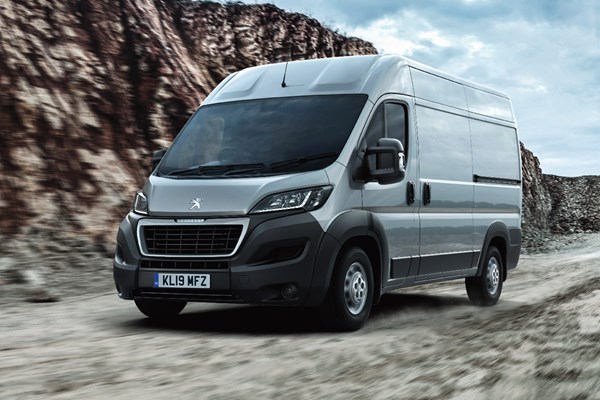Peugeot Boxer van review (2023)
Big, practical and efficient but getting ancient now
PROS
- Big payload capacity
- Large load area
- Available in many variants
- Euro 6 engines highly efficient
- Good value
CONS
- Starting to feel its age
- Noisy on the motorway
- Tiring to drive
- Lacks latest safety options
- Model designations can confuse
Summary
This 2023 Peugeot Boxer review covers the fifth-generation version of Peugeot's popular large van. It's one of the oldest vans still on sale, but has been repeatedly updated in an effort to keep it relevant, and offers one of the higher payload ratings for a 3.5-tonne van in the UK.
Beneath the branding, the Boxer is the same van as the current Citroen Relay and Fiat Ducato, as well as the latest Vauxhall Movano. When first introduced in 2006, they each represented a big step forward in driver and passenger comfort, thanks to an improved driving experience and ergonomics.
However, it's now a decade and a half later, and this platform has been overtaken in these areas by almost every other large van on sale. So although the Boxer's most recent update was in July 2019, it does feel rather old now.
Still, it remains right at the top of the class when it comes to payload and fuel economy.
There is also a Peugeot e-Boxer electric van based on this model.
New 2.2-litre BlueHDi engines in 2019
From July 2019 production, the 2.0-litre BlueHDi engines introduced just three years earlier were scrapped in favour of a new range of 2.2-litre BlueHDi engines.
These boast more power across the range (and more torque at the very top), come with stop-start as standard and complies with the Euro 6D Temp (or Euro 6.2) emissions regulations introduced in September 2019.
New 2.0-litre BlueHDi engines in 2016
Following a cosmetic makeover in 2014, September 2016 saw the Boxer switch over to a new 2.0-litre BlueHDi turbodiesel engine range in compliance with the then current Euro 6 emissions regulations.
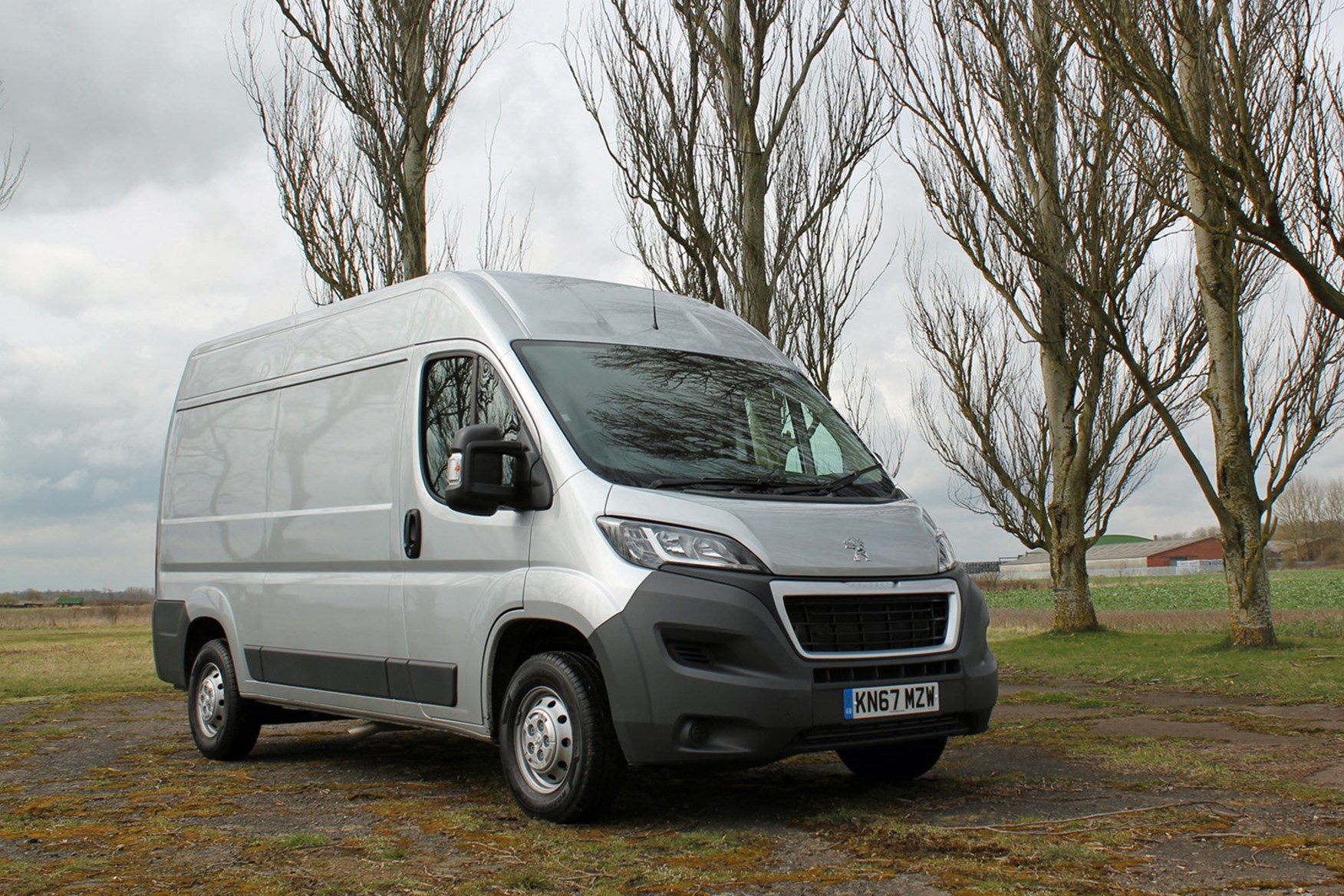
These replaced the previous 2.2-litre HDi and 3.0-litre HDi Euro 5 engines - though the Boxer is so old it actually launched with 100-160hp Euro 4 diesels.
The new ‘downsized’ 2.0-litre BlueHDi engines were revised versions of motors already familiar from Peugeot’s cars. Uprated to cope with commercial vehicle work, they offered slight performance and official fuel economy upgrades over the outgoing Euro 5 engines, but Peugeot soon took the decision to switch back to 2.2-litres for its large van.
Plenty of variants
The Boxer van – which comes in panel and window versions – is available in four body lengths, three wheelbase lengths and three heights. The larger models can be had with a heavy-duty suspension option for better axle-distribution of the load capacity.
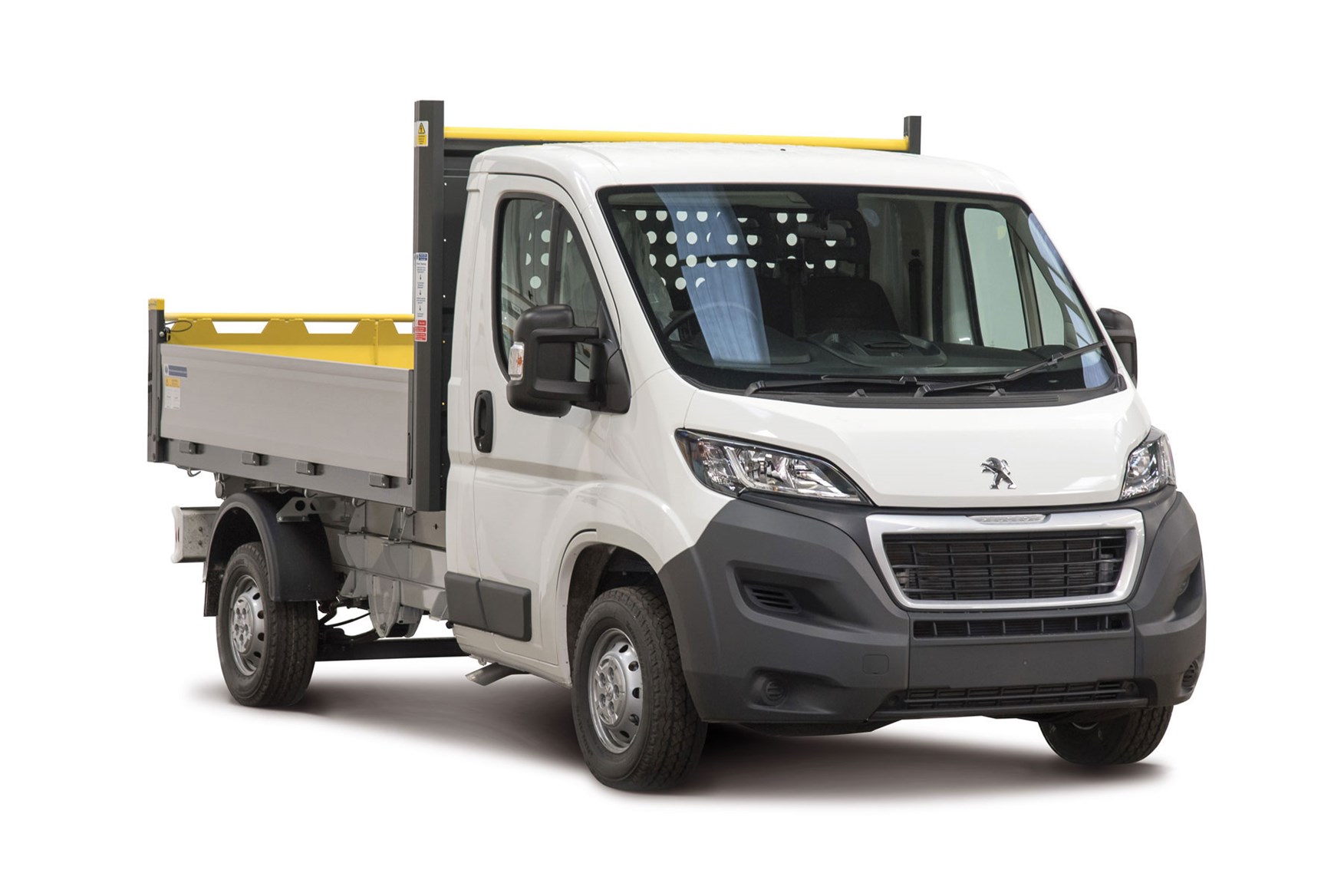
A range of 'Built for Business' ready-made conversions was launched in 2018 to further boost customer choice, while more recent changes have seen the number of trim levels increased from two to four.
>> Peugeot launches Built for Business conversions range
Peugeot Boxer rivals
As one of the oldest vans in the large van sector, the Boxer struggles to compete in terms of ease of use with the latest premium rivals, such as the 2018-on Mercedes-Benz Sprinter and 2017-on Volkswagen Crafter - and the latest Ford Transit, which was heavily upgraded in 2019.
So it's better to think of the Peugeot as a competitor to the aging Renault Master family, which includes the Nissan NV400 and Vauxhall Movano. Vauxhall is now part of the same Groupe PSA family of companies as Peugeot, however, so will soon be based on the same technology as the Boxer as well.
Is there an electric version of the Peugeot Boxer?
The Peugeot e-Boxer electric van went on sale in 2021, offering a claimed maximum driving range of 211 miles.
Verdict:
This is a van that is fundamentally strong value. Its payload ratings are among the best of any 3.5-tonne van, fuel economy is genuinely impressive and you’ll get a good deal if you shop around.
But, compared with more rivals such as the Ford Transit, Mercedes-Benz Sprinter and VW Crafter, you’ll find the Boxer is noisy and tiring to drive.
Keep reading for our full Peugeot Boxer review, or see our dedicated Peugeot Boxer dimensions page for dimensions and payload info.
Skip to our full verdict on...
- Engines provide plenty of power
- Uncomfortable on longer journeys
- Noisy and not good to drive compared with modern rivals
You shouldn’t have any trouble getting the Boxer up to speed – whether it’s the newer 2.2-litre HDi turbodiesels or the older versions, the engines are willing and easily able to keep pace with motorway traffic.
You will also find the turning circle and general manoeuvrability impressive, even in the Boxer’s larger sizes.
Noisy and tiring to drive
However, refinement is not very good. The very latest 2.2-litre models are a little better, but you'll still find lots of road and engine noise fills the cab when travelling at even a moderate pace. This contributes to it feeling cheap and basic compared with more recently released alternatives – the Volkswagen Crafter and Ford Transit in particular.
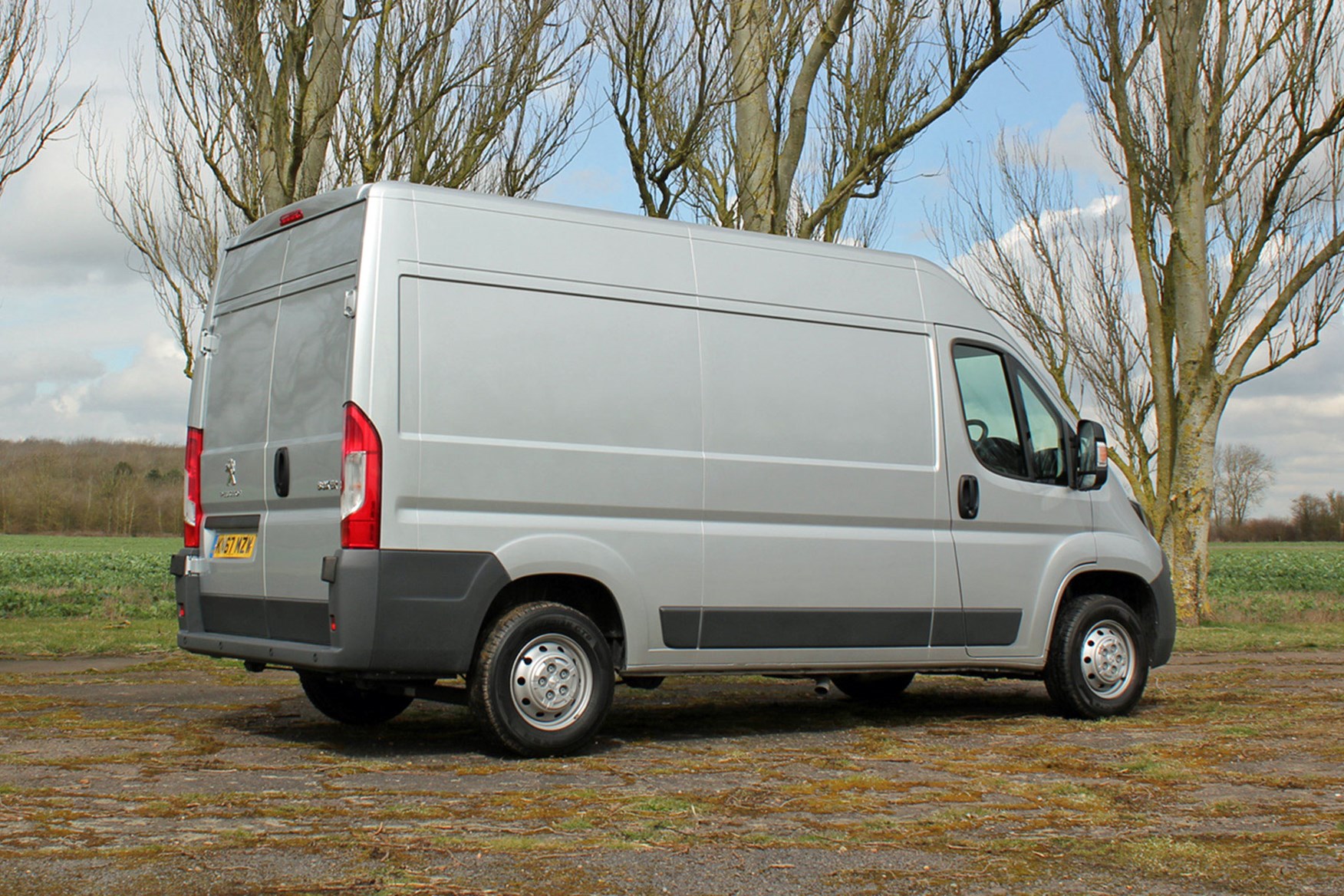
Worse still, the Boxer tends to follow ruts in the road quite heavily, to the extent that at motorway speeds you may find yourself with a bit of a fight on your hands just to drive straight. It certainly isn’t very relaxing over longer distances, also being rather susceptible to side winds.
When travelling unloaded the suspension is harsh and bouncy – particularly with the 400-series' heavy-duty suspension. This should settle down once there is some weight in the back, but you’re unlikely to find the Boxer especially comfortable to drive.
Choice of only two power outputs
While the number of trim levels increased in 2020, the choice of available engine power outputs from the latest 2.2-litre range has been cut back to just two - a 120hp model with 310Nm of torque and 140hp model with 350Nm.
This makes the Boxer one of the least powerful large vans on sale.
Similarly, the only gearbox option is a six-speed manual transmission - many rivals offer highly effective automatics with many more gears now, making urban driving easier and keeping engines quieter on the motorway.
Visibility is a mixed bag
There are large, split-view door mirrors, and you can option both parking sensors and a reversing camera.
But the side windows are obstructed by a dividing quarter-light panel, and you need to be careful to judge the length of the Peugeot’s front bumper, which extends quite a long way forward and is out of sight from the driver’s seat.
- Spacious and reasonably equipped
- Some unusual ergonomics
- Poor refinement and long-distance comfort
When first launched we praised this generation of Boxer for its car-like driving environment, and it remains spacious for all three passengers.
Middle seat passengers will be particularly glad to see that the gearlever is very close to the steering wheel leaving them loads of knee room. Drivers will find this positioning makes it easier to manage the slightly reluctant shift mechanism, too.
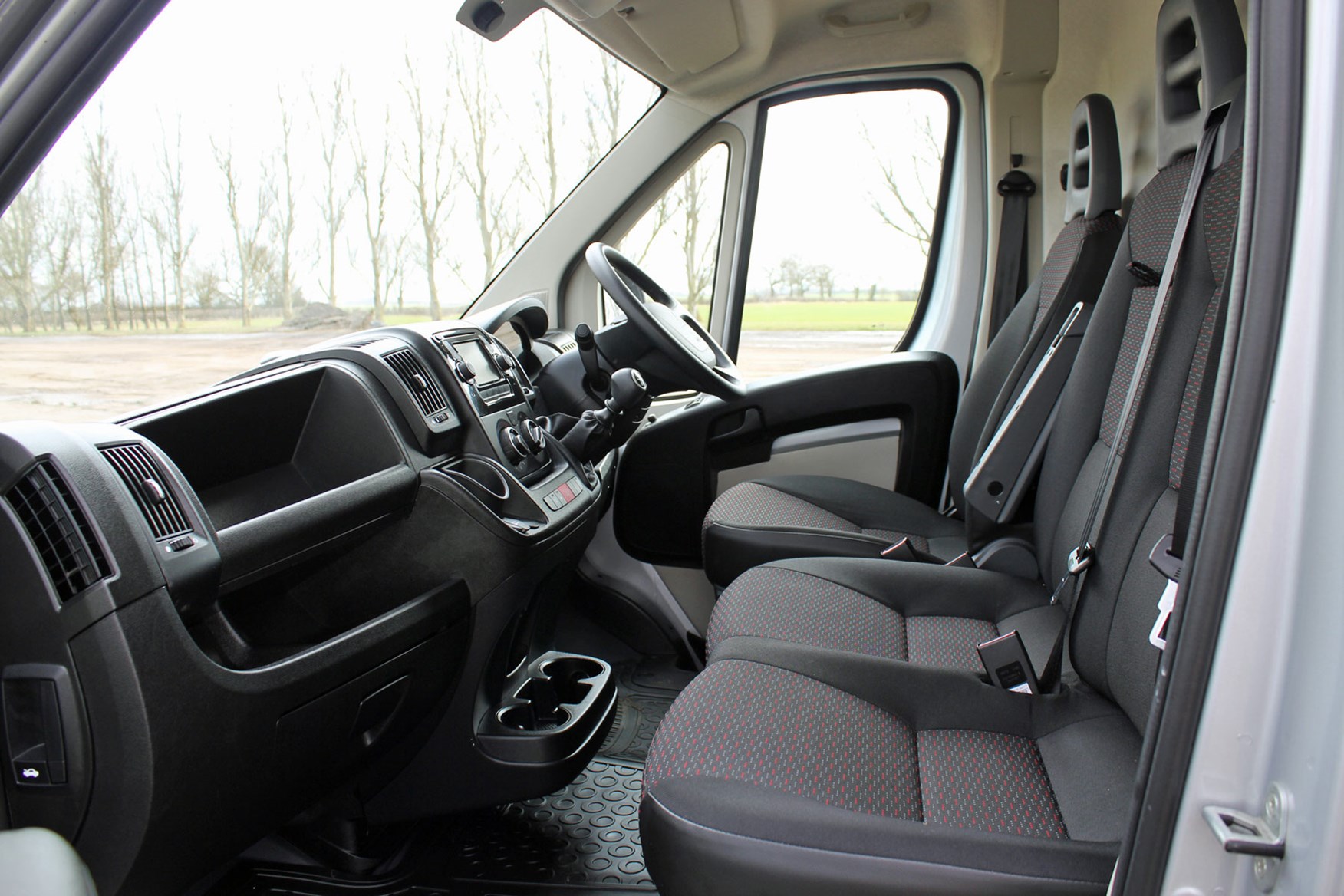
The driver’s seat has plenty of adjustability, but the steering wheel is mounted quite low and flat.
Unusually, the handbrake is on the right side of the driver. Again this is a boon for the middle passenger - just watch you don't catch yourself on it getting in and out if you're the driver.
Peugeot Boxer in-cab storage
In-cab storage looks generous at first. But most of the cubbies are open rather than covered, and the door pockets aren’t as user friendly as some rivals. The availability of an overhead bin varies with model.
Build quality is generally acceptable; where the Boxer starts to struggle compared to more modern rivals is in terms of refinement and the physical driving experience.
- Good fuel economy
- Lengthy service intervals
- Reasonable standard equipment and value
Not being as modern as many rivals does at least make the Peugeot Boxer light in weight, which is good news for running costs.
Peugeot Boxer mpg
For the latest 2.2-litre HDi engines, Peugeot has adjusted the fuel economy figures in line with the newest WLTP standard, which means these Boxers look substantially less efficient than older models.
In the real world this should be the case, rather the adjustment should make the official figures more accurate. Though you should still consider them as more useful for comparison than working out exactly how much you'll be spending on fuel when you buy one.
For reference, then, the 120hp engine is claimed to return 26.6-34.9mpg, while the 140hp claims 25.5-34.2mpg.
Peugeot Boxer warranty and servicing
The Boxer comes with a two-year, unlimited mileage manufacturer’s warranty, which is extended to three years for up to 100,000 miles – assuming that you stick to the correct service intervals.
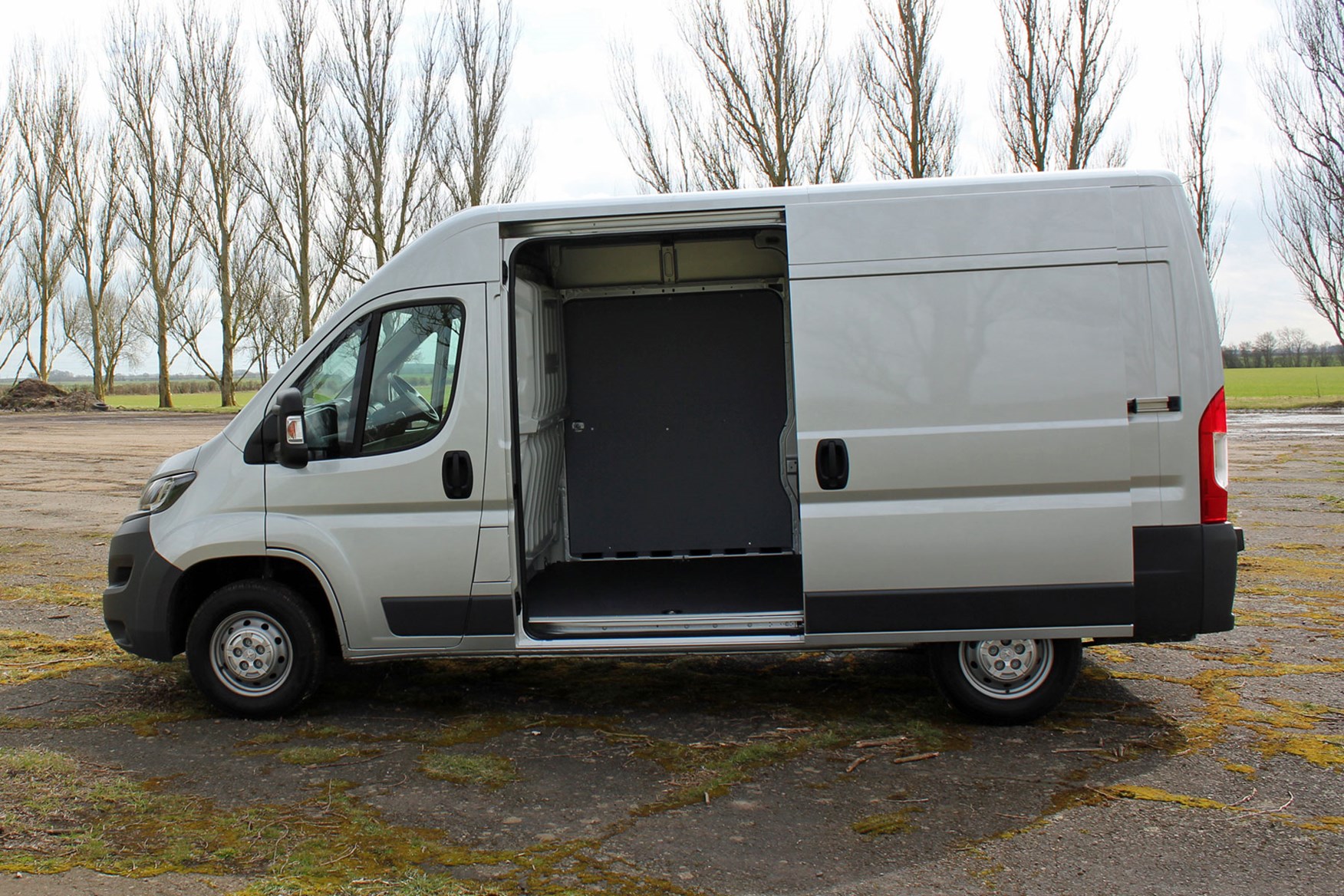
This needn't be too galling, as service intervals for the latest 2.2-litre BlueHDI engines are now up to 32,000 miles, while the 2.0-litre BlueHDi engines promise 30,000 miles between dealer visits.
Those are two-year intervals - so whichever is sooner - though Peugeot also says heavier users should plan to see a service centre every 12,500 miles or one year.
At their max, those are both an increase over the 24,000-mile intervals of the Euro 5 2.2-litre engines, themselves a significant improvement over the Euro 4 models, some of which require servicing every 12,500 miles.
Peugeot Boxer standard equipment
The current Boxer range comes in four trim levels: S, Professional, Grip and Asphalt - matching the rest of the Peugeot van range. These are the current standard equipment highlights (at time of writing in January 2021).
Peugeot Boxer S standard equipment highlights:
- DAB radio, Bluetooth and USB connectivity
- Peugeot Connect telematics box for Free2Move Connect Fleet Services
- Reach-adjustable steering wheel with audio controls
- Height-adjustable driver's seat
- Electric windows
- Twin-lens door mirrors with electric adjustment and heated upper lenses
- Rear doors with 180-degree opening
- Sliding side door on the passenger side
- Full steel bulkhead
- Half-height load area protection
Peugeot Boxer Grip standard equipment highlights (in addition to S):
- Cruise control with variable speed limiter
- Lower central glovebox (instead of cupholders and phone storage)
- Lumbar adjustment and armrest for driver's seat
- Grip Control electronic traction control system with Hill Descent Control
- Underbody protection plate
- Reinforced suspension
- All-season tyres
- Front and rear mudflaps
Peugeot Boxer Professional standard equipment highlights (in addition to S rather than Grip):
- Touchscreen infotainment system with sat-nav
- Air-conditioning
- Cruise control with variable speed limiter
- Touchscreen infotainment system with 5.0-inch screen
- Rear parking sensors
- Lower central glovebox (instead of cupholders and phone storage)
- Lumbar adjustment and armrest for driver's seat
Peugeot Boxer Asphalt standard equipment highlights (in addition to Professional):
- Rear parking camera
- LED daytime running lights in the headlights
- Automatic lights and wipers
- USB charging socket and tablet holder on dashboard
- Driver Assist Pack for added safety equipment
As you can see, the Grip and Asphalt models are more specialised versions, with the Grip designed to make life easier on slippery work sites and similar, while the Asphalt is intended to improve comfort and convenience for long-distance drivers.
For more details of safety and security equipment, see the Safety and Security section of this review.
Previous generations of the Boxer van have proved largely reliable with no reports of any significant issues or problems.
The older diesel engines in this model have a proven track record, and the newer 2.0-litre motors have undergone an extensive testing programmed to make sure they’re up to the task of hauling a heavy van; since they are also a development of an engine that’s been in use in Peugeot’s cars since 2013, they should prove dependable.
Peugeot Boxer Recalls
This model of Boxer has been subject to a number of recalls – with the most serious concerns relating to braking efficiency, steering stiffness and the handbrake not working correctly.
Other issues include spare wheels becoming detached, indicators not working properly, engine stalling problems and – most recently – instrument displays switching themselves off.
If you’re buying new all of these troubles should have been corrected on the production line, but if you’re buying used it’s worth making sure any applicable recalls have been completed.
- Not much in the way of the latest safety kit
- Alarm standard on Professional trim level
As one of the oldest vans on the market, the Boxer can't compete with newer rivals when it comes to the latest safety kit. Here's what you get - and what you miss out on.
Peugeot Boxer safety equipment
A driver’s airbag is fitted as standard with the option of passenger airbag (which can be deactivated via a key), side airbags and curtain airbags. The three-point seat belts are fitted with pre-tensioners and load limiters.
Electronic stability control and Bluetooth hands-free telephone connection are standard, too. But the Boxer is too old to be offered with many of the latest active safety aids that are starting to appear in the van world such as blindspot monitors and lane-keeping assistance.
That said, automonous emergency braking and lane departure warning have been made standard on the heaviest 4.0-tonne gross vehicle weight versions (badged 440), however, and come as part of the Driver Assist Pack on the new Asphalt trim level. These are also available as options on the rest of the range.
All but the most S models get standard cruise control as well, although conversely this is not available on the 4.0t models.
Peugeot Boxer security equipment
All Boxers are fitted with an immobiliser as standard, while the Professional and Asphalt models are fitted with an alarm.
The door locks can be operated independently, with the key fob able to unlock only the cab doors or unlock only the load space doors or unlock all doors.
Standard deadlocks also means that even if a window is smashed the door cannot be unlocked via the interior door handle.
Which Peugeot Boxer is best for me?
There are plenty of different Peugeot Boxer variants to choose from - it's available in four body lengths and three roof heights, in one of two trim levels and with a choice of three engines. Here are the variants we've tried out.
Peugeot Boxer Professional (L2 H2) 130hp 2.0-litre BlueHDi review
Tested in July 2019 by Tom Wiltshire
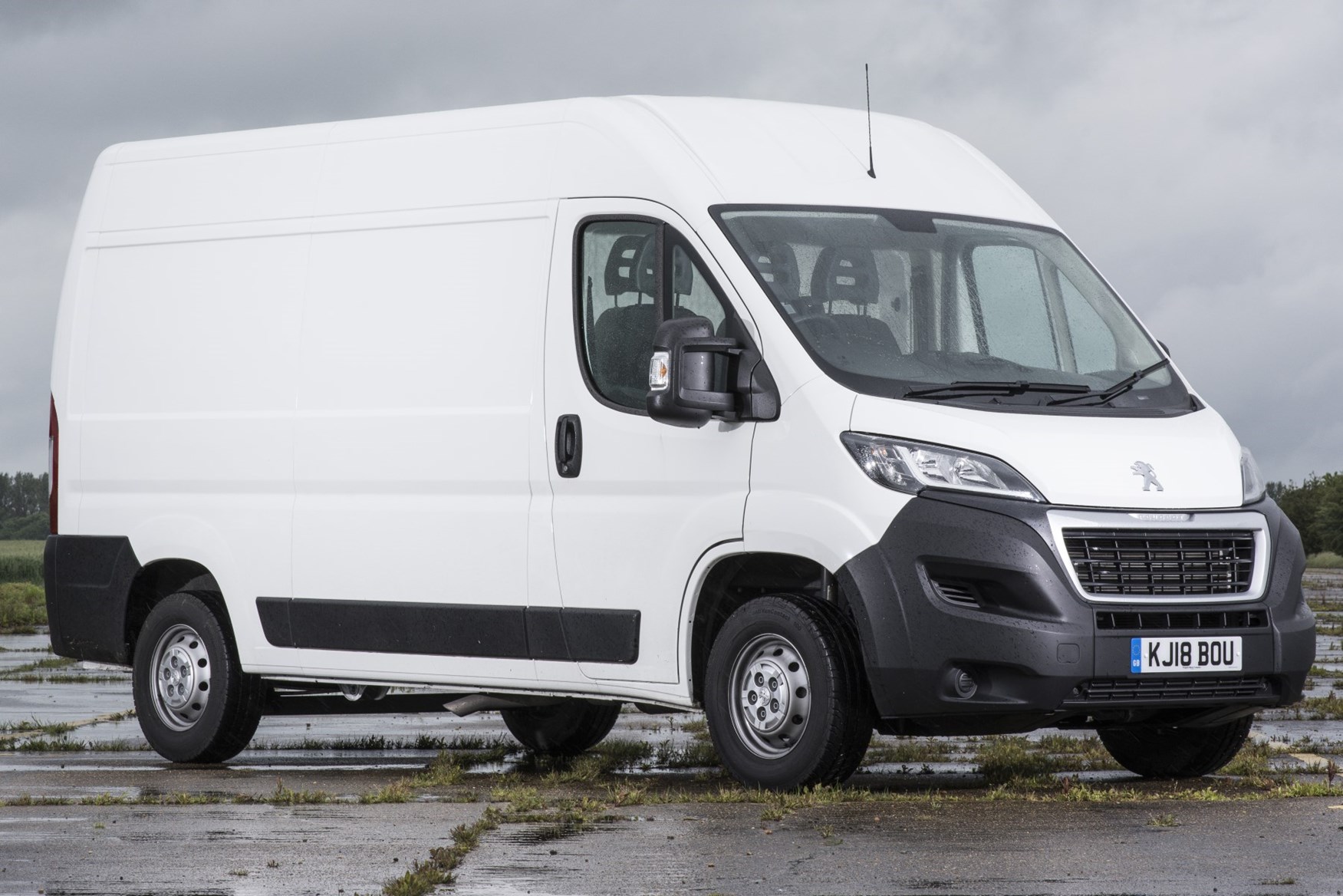
- Mid-spec 130hp engine in for review
- L2 length and H2 height is best combination for payload
- Plush (ish) Professional trim offers some creature comforts
The Peugeot Boxer’s been around for quite some time – the current variant was last updated in 2016, when it received a glut of Euro 6 diesel engines. In terms of styling and interior fittings, though, it’s been business as usual since 2014, but does that leave this big French box feeling outdated?
Driving experience isn’t up there with the best
There’s no hiding the Peugeot’s age – together with its Citroen and Fiat siblings, it’s been on sale in the same basic form since 2006. This means it can’t hold a candle to rivals such as the Ford Transit or the Volkswagen Crafter in terms of driving experience.
The Boxer is available with a downsized 2.0-litre diesel, available in 110hp, 130hp and 160hp variants. All are paired to a six-speed manual gearbox – those who need an automatic are out of luck, though Fiat does offer one in the mechanically similar Ducato. The Ducato’s own-brand engines are also more efficient for their power output.
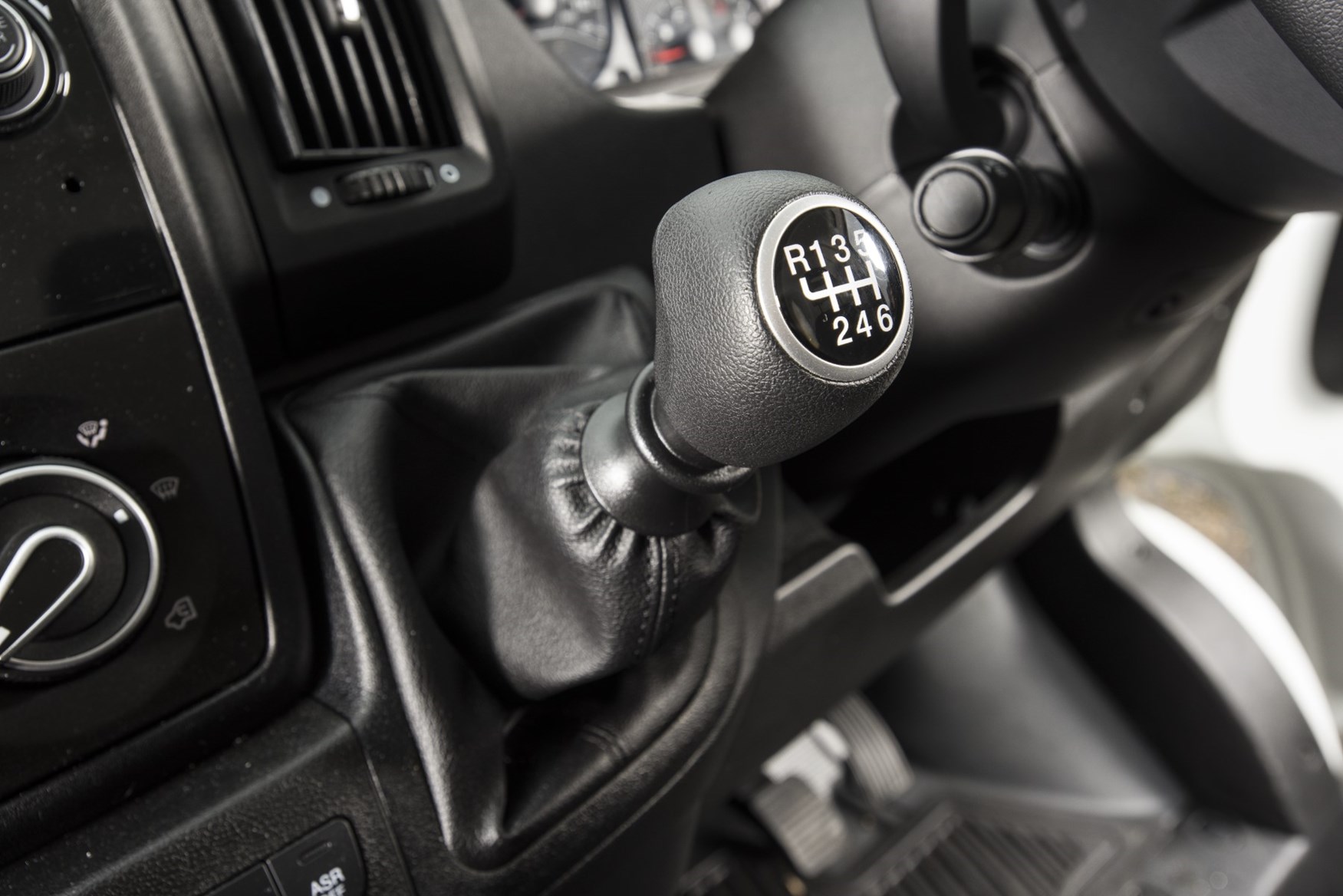
Our 130hp model pulled well even when fully laden, and unless you’re regularly travelling with a full payload – or perhaps a motorhome conversion – we don’t see the need for the top-spec 160hp engine. The gearbox is ideally positioned high up on the dash, but its action is a little notchy.
It’s in the ride and handling stakes where the Boxer loses out to newer rivals, though. The steering is over-light and a little inaccurate, and the unladen ride less compliant than the Mercedes Sprinter.
Dated-feeling cab
In contrast with the huge touchscreens offered in more modern rivals, the Boxer uses a Fiat-derived infotainment system with a 5.0-inch screen. It’s not as up-to-date as it could be, not offering any form of smartphone connectivity like Apple CarPlay or Android Auto, and though it offers a slick TomTom sat-nav system it can be hard to see on such a small display. All models do get DAB radio, Bluetooth and USB inputs, though – however it’s worth mentioning that the latter is only a 1.0A output, rendering it incapable of keeping a modern smartphone topped up if it’s being used for navigation.
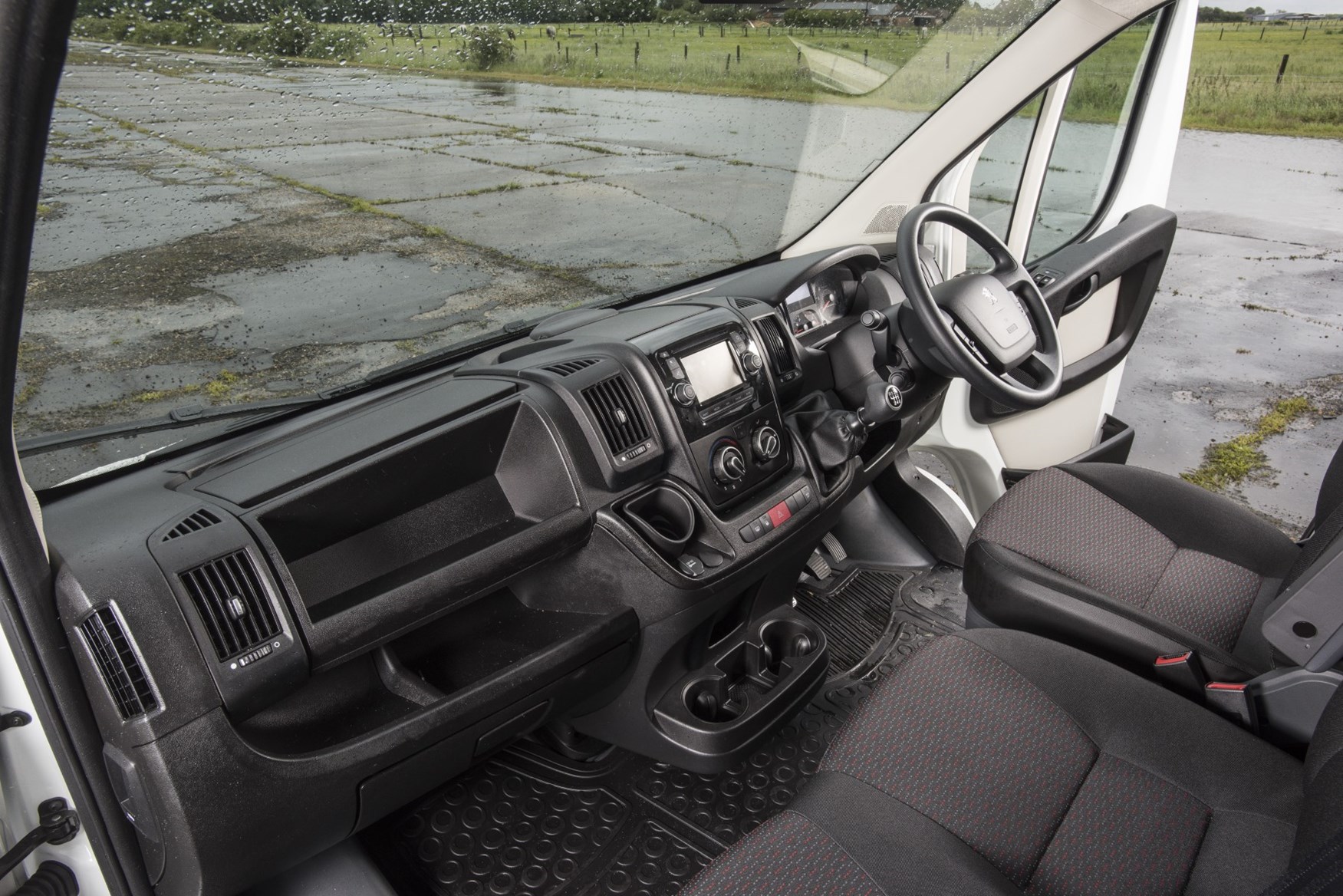
The dual passenger seat is upright but reasonably supportive, and the dashboard leaves plenty of knee-room. If travelling with nobody in the centre seat, its backrest flips down to become a clipboard. A further clipboard folds out from above the infotainment screen.
Storage spaces are more than adequate, with two large glove boxes, cubbies above the windscreen and storage space under the seats. However, the double cupholder – added in the 2014 facelift – is positioned virtually on the floor, meaning it’s not very easy to reach on the move.
Our test van was in ‘Professional’ trim, bringing with it over the standard model an alarm, cab air-conditioning, cruise control and rear parking sensors. On the options list are folding door mirrors, a useful rear parking camera, air suspension and a lorry-like suspended driver’s seat.
Stellar payload and impressive load space
All Boxers come as standard with a full-height bulkhead, and the load area is one of the most practical in its class. There’s a choice of three roof heights and four body lengths, and all are among the most roomy in their class. The tallest H3 vans offer more loading height than the Ford Transit, while there’s room between the wheelarches to load a Euro pallet sideways. There’s also ample width in the sliding door to load through there, though short-wheelbase models have a slightly smaller opening.
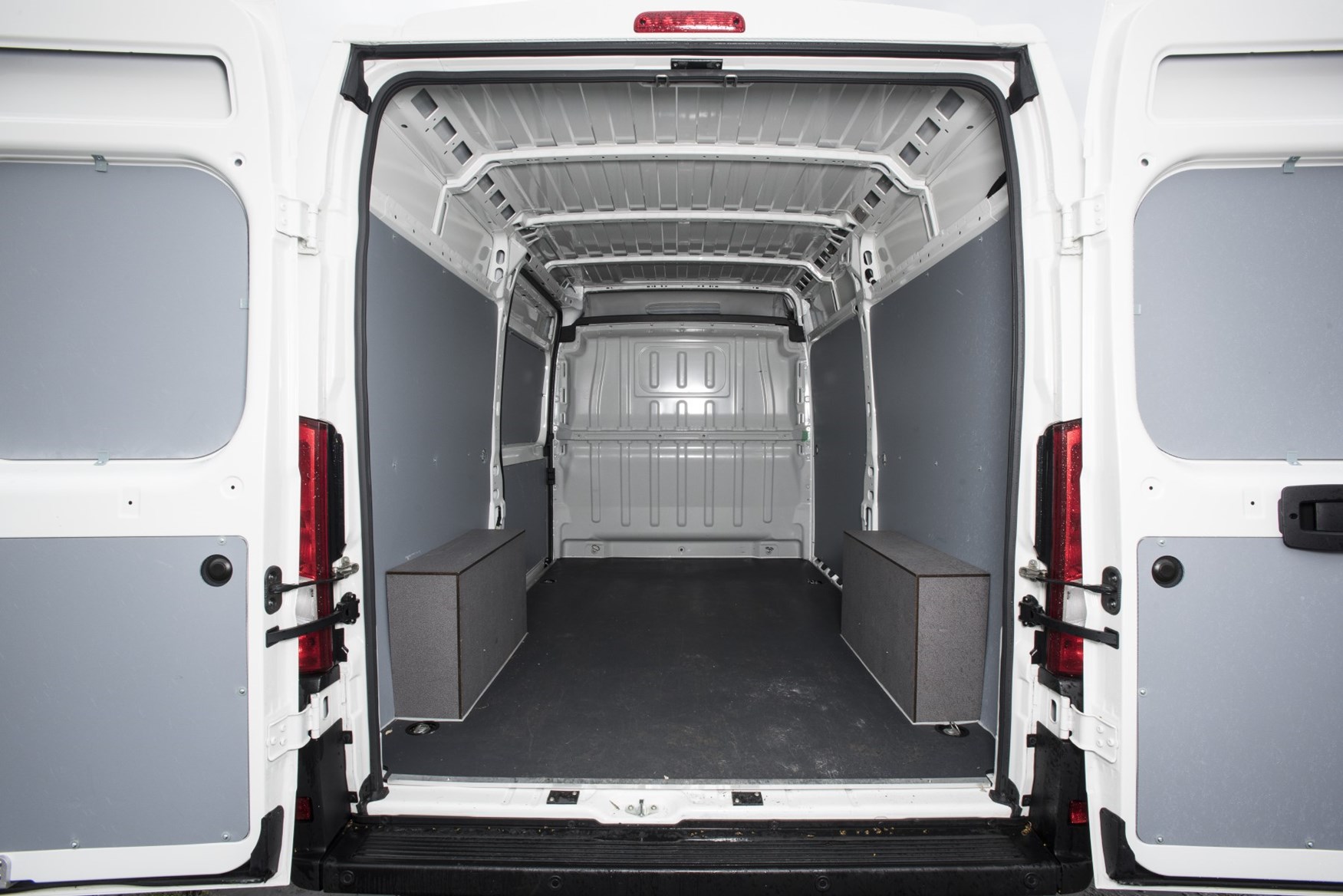
The Boxer’s load area is lit and fitted with at least eight lashing points as standard, though it’s slightly stingy of Peugeot to not include even a lined floor as standard. The rear doors open to 180 degrees as standard, and to 270 degrees as a cost option.
Payloads are among the highest in this class of van. Though payloads dropped a little with the addition of an AdBlue tank in 2016 (necessary to meet Euro 6 emissions standards) our L2 H2 model could still carry up to 1,575kg – a seriously impressive amount, and more than 100kg more than a comparably-sized Ford Transit.
You can read more dimension and payload info on our dedicated page by clicking here.
Should I buy one?
The Peugeot Boxer feels dated and unrefined compared to the latest slew of deeply impressive vans on offer from Ford, Volkswagen and Mercedes. A small update later in 2019 may go some way to fixing this, but we wouldn’t bank too much on it – the van’s basic design dates back to 2006, after all.
However if your main priority is efficiency and payload, the Boxer takes some beating. With some of the highest ratings in this class of van and a superbly practical load area, it’s very good at carrying stuff – and in the end that’s what a van’s all about.



